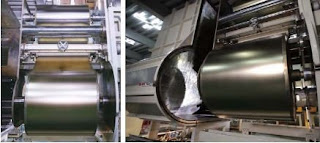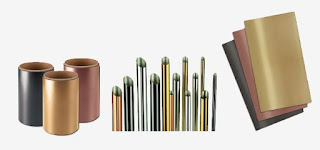World-class leading manufacturer of Titanium Color Coating | DSP
DSP Co., Ltd. is a world top-tier color-coated metal sheet and tube manufacturer in Korea. DSP Titanium color coil is manufactured by the physical Vapor deposition method where a chunk of titanium is placed into the high vacuum to produce a perfect titanium coating. This cutting-edge ultra-functional product is widely used in many areas including automotive, electrical, and electronic industries.
What
is PVD Titanium Color Coating
Physical Vapor Deposition (PVD) is a method
used to deposit layers of the coating by using the condensation from the
vaporized form of material and applying it to the desired target material. PVD
is achieved by taking titanium Alkoxide (titanium mass) and applying a positive
voltage to it while it is inside a high-temperature vacuum. This releases
positively charged titanium molecules. Inside the vacuum is a material, such as
stainless steel, that has a negative voltage applied to it. The negative
voltage attracts the positively charge titanium molecules and results in the
material being coated. Plasma cleaning and ion impact processing of materials
are needed to improve the adhesion of the coating. This results in the coating
having a longer lifespan. PVD technology has significantly contributed to a
variety of fields including car manufacturing, electronics, and other
industries.
Features
and merits of DSP Titanium Color Coating
ü Thin Film Hardness: The hardness of the product film itself was measured by the Vickers
hardness test and was found to be about 10 times harder than stainless steel.
ü Adhesion of the coating: The strength of the adhesion was tested by creating a 2mm wide
scratch with a knife and attempting to peel off layers of the coating with
cellophane tape. There was no peeling of the cellophane tape. coloured
stainless steel manufacturer
ü Impact Resistance: A 1kg steel ball was dropped from a height of 50cm onto the product
using a DuPont impact tester. There were no abnormalities such as discoloration
or damage visual observation.
ü Abrasion Resistance: Using a SUGA abrasion tester 500g of pressure from an eraser was
applied to 0.5 microns of ion plating. The applied pressure was repeated 200
times. The ion plating film was not peeled.
ü Scratch Hardness: Load of cracking point, as seen below, was tested by scratching
150mm per minute with the Kuremence Scratch Tester. The result showed Ion
coating was 3 times harder than the chemical coating on scratch-resistant
hardness. decorative stainless steel supplier
ü Artificial Sweat Test: The Ion-Coated frame was pre-soaked in artificial sweat of PH 4.5,
JISLO 848 for 8 hours and left at room temperature for 16 hours.



Comments
Post a Comment